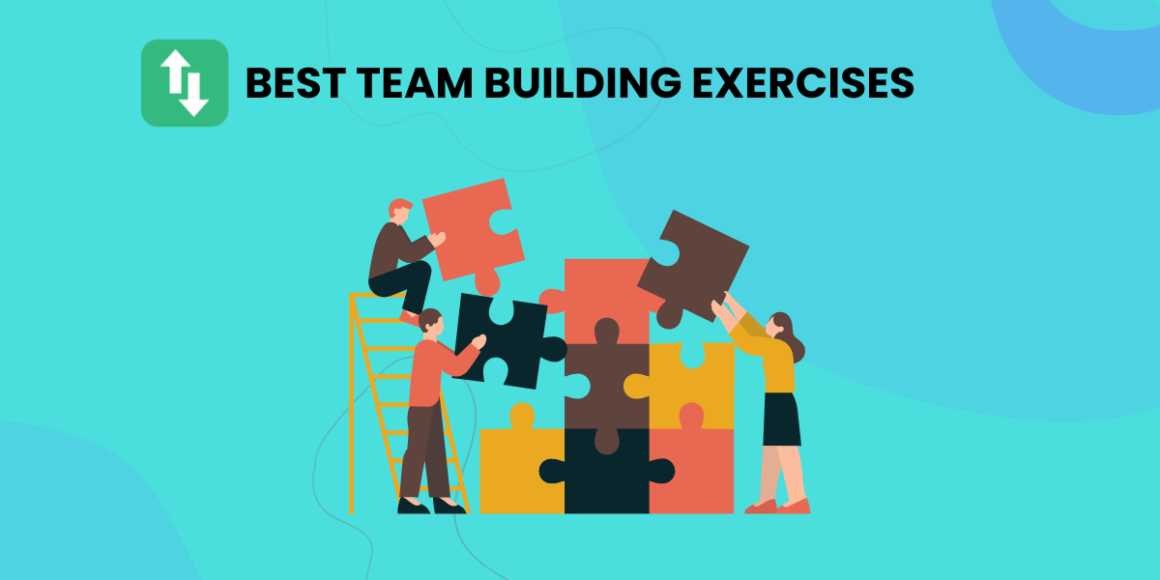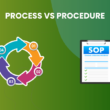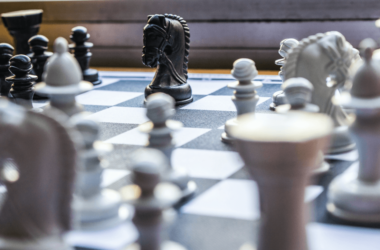Table of Contents Show
Team building exercises are structured activities designed to enhance interpersonal relationships and improve collaboration within a group. These exercises play a crucial role in fostering a positive workplace culture, where employees feel connected and engaged with their colleagues.
In today’s fast-paced work environment, effective teamwork is essential for achieving organizational goals, driving innovation, and enhancing productivity.
The significance of team building cannot be overstated; it helps break down barriers, encourages open communication, and cultivates trust among team members. When employees participate in team bonding activities, they develop a deeper understanding of each other’s strengths and weaknesses, leading to improved synergy and cooperation.
This article will explore the best team-building exercises of 2024, highlighting various activities that cater to different group sizes and dynamics. From fun team-building games to effective problem-solving tasks, we will provide you with a diverse array of options to help strengthen your team’s bond and enhance overall performance.
What is Team Building?
Team building refers to a series of activities and exercises aimed at improving the cohesion and performance of a group. It focuses on fostering collaboration among team members, enhancing interpersonal relationships, and developing a sense of community within the workplace.
At its core, team building is about understanding team dynamics—how individuals interact, communicate, and work together toward common objectives. Effective team dynamics are essential for any organization.
They enable teams to navigate challenges more efficiently, leverage diverse skill sets, and drive innovation. By engaging in team building activities, members learn to appreciate each other’s contributions, leading to a more harmonious work environment.
This understanding is particularly crucial in today’s diverse workplaces, where teams often consist of individuals from various backgrounds and experiences.
Benefits of Team Building Activities
Engaging in team building exercises offers numerous advantages that extend beyond mere enjoyment.
Here are some key benefits:
1. Enhanced Communication
One of the primary goals of team building activities is to improve communication among team members. When employees participate in structured exercises, they practice articulating their thoughts and ideas in a supportive environment.
This open dialogue fosters better understanding and reduces the likelihood of misunderstandings in daily interactions. As communication improves, teams can collaborate more effectively on projects, leading to increased efficiency.
2. Increased Trust and Collaboration
Trust is the foundation of any successful team. Team bonding activities help build trust by encouraging vulnerability and openness among participants.
When team members engage in challenges that require them to rely on one another, they develop a stronger sense of camaraderie. This trust translates into better collaboration, as employees feel more comfortable sharing their opinions and taking risks within the group.
3. Improved Morale and Job Satisfaction
Participating in fun team-building activities can significantly boost employee morale. When teams engage in enjoyable exercises, they create positive memories together, which enhances their overall job satisfaction.
A happy workforce is more productive and motivated, leading to lower turnover rates and a more stable organizational culture. By prioritizing team building, companies can cultivate an environment where employees feel valued and connected to their work and colleagues.
Types of Team Building Exercises
Team building exercises come in various forms, each designed to address specific aspects of team dynamics and collaboration. Here’s a closer look at the different types of team-building activities and their unique benefits.
1. Icebreakers
Icebreakers are short, engaging activities that help participants get to know each other better and ease any initial tension. The primary purpose of these exercises is to create a comfortable atmosphere where team members can communicate openly.
2. Problem-Solving Activities
Problem-solving activities are essential for fostering critical thinking and collaboration within teams. These exercises challenge participants to work together to find solutions to complex problems, enhancing their ability to think creatively and strategically under pressure.
3. Creative Activities
Creative activities stimulate innovation and allow team members to express their ideas in unique ways. These exercises encourage out-of-the-box thinking, which can lead to improved collaboration on work-related projects.
4. Physical Activities
Physical activities promote health while enhancing teamwork through shared experiences. Engaging in sports or outdoor challenges allows team members to bond in a different context, fostering camaraderie beyond the office environment.
45 Top Team Building Exercises:
We have divided team collaboration exercises into different categories. Let us have a look to them:
Icebreakers Team Building Exercises:
Here’s a closer look at some effective icebreaker exercises:
1. One-Word Icebreaker
In the One-Word Icebreaker, participants take turns sharing a single word that encapsulates their current mood or feelings about the day. This exercise is simple yet powerful, as it encourages self-reflection and opens the floor for discussion. It allows team members to express themselves without the pressure of elaborating too much. This activity can also reveal shared sentiments, helping to foster empathy and understanding within the group.
2. Two Truths and a Lie
Two Truths and a Lie is a classic icebreaker that promotes engagement and interaction among team members. Each participant shares two true statements and one false statement about themselves, while others guess which one is the lie. This game encourages storytelling and helps team members learn interesting facts about each other, breaking down barriers and fostering connections. It’s particularly effective in creating a light-hearted atmosphere where everyone feels comfortable sharing personal anecdotes.
3. Emoji Reactions
In the Emoji Reactions activity, participants use emojis to express their feelings about a specific topic or situation, such as a recent project or team goals. This can be done through digital platforms or by using physical emoji cards in face-to-face settings. The visual nature of emojis makes it easier for team members to communicate emotions that might be difficult to articulate verbally. This exercise encourages creativity and can lead to insightful discussions about team dynamics and sentiments.
4. Quick Pictionary
Quick Pictionary is a fun drawing game that requires teams to guess words or phrases based on drawings created by their teammates within a set time limit. Participants take turns drawing while others try to guess what is being illustrated. This activity promotes teamwork, quick thinking, and creativity while providing plenty of laughs. It also encourages non-verbal communication skills, as participants must convey ideas through visuals rather than words.
5. Story Building
In the Story Building exercise, each team member contributes one sentence to create a collaborative story. This activity can start with a prompt or theme, allowing participants to build on each other’s ideas in real time.
Story Building fosters creativity and collaboration while encouraging participants to listen actively and think critically about how their contributions fit into the larger narrative. It’s an excellent way to spark imagination and showcase diverse perspectives within the group.
6. Office Scavenger Hunt
The Office Scavenger Hunt involves teams racing against each other to find specific items around the office based on a list of clues or challenges provided by the facilitator.
This activity encourages teamwork, strategic thinking, and communication as participants work together to solve clues and locate items efficiently. It also adds an element of fun to the workplace, breaking up routine tasks and promoting movement around the office.
7. Name That Tune
In Name That Tune, the facilitator plays short clips of songs, and participants must guess the title or artist as quickly as possible. This game can be tailored to include songs relevant to the team’s interests or shared experiences, making it more engaging.
Name That Tune not only serves as an entertaining icebreaker but also stimulates friendly competition among team members, enhancing camaraderie through shared enjoyment of music.
8. Photo Storytelling
Photo Storytelling invites participants to share a personal photo (from their life or travels) and create a story around it. Each member takes turns presenting their photo and explaining its significance or context, which fosters deeper connections among team members as they share personal experiences and memories.
This activity promotes active listening and empathy while allowing individuals to showcase their personalities in a meaningful way. These icebreakers serve as effective tools for building rapport among team members, encouraging open communication, and creating an inclusive environment where everyone feels valued and connected from the outset!
Problem-Solving Activities
Here’s a detailed look at some effective problem-solving activities:
9. Marshmallow Challenge
The Marshmallow Challenge is a hands-on activity where teams are tasked with building the tallest freestanding structure using only 20 sticks of spaghetti, one marshmallow, one yard of string, and one yard of tape. Teams typically have 18 minutes to complete the challenge. This exercise emphasizes creativity, collaboration, and time management as participants must strategize and experiment with different designs. The activity highlights the importance of prototyping and iterative thinking, as teams learn that their initial ideas may need adjustments to achieve success.
10. Blind Drawing
In the Blind Drawing activity, participants are paired up, with one person designated as the “drawer” and the other as the “describer.” The describer has an image that the drawer cannot see and must provide verbal instructions to replicate it without naming any objects. This exercise emphasizes clear communication and active listening, as the drawer relies solely on the describer’s guidance. Afterward, pairs can compare their drawings with the original images, leading to discussions about miscommunication and strategies for clearer expression.
11. Escape Room Puzzles
Escape Room Puzzles involve solving a series of challenges or riddles within a themed room to “escape” before time runs out. These can be physical escape rooms or virtual versions played online. Teams must communicate effectively and leverage each member’s strengths to solve puzzles collaboratively. This activity fosters teamwork under pressure while enhancing problem-solving skills and creative thinking as participants navigate through various challenges.
12. Balloon Tower
In the Balloon Tower challenge, teams are given a limited number of balloons and tape to construct the tallest tower possible within a set timeframe (usually around 15-20 minutes). This activity encourages collaboration and innovative thinking as team members must brainstorm designs that maximize height while ensuring stability. The exercise also promotes resourcefulness, as teams learn to use limited materials creatively.
13. The Egg Drop
The Egg Drop challenge requires teams to design a protective structure for an egg using various materials (like straws, cardboard, or tape) so that it can survive a drop from a certain height without breaking. Teams must collaborate on their designs, testing their engineering skills while considering factors like weight distribution and impact resistance. This exercise not only fosters teamwork but also encourages experimentation and learning from failure.
14. Communication Relay
In the Communication Relay, teams relay messages through whispers, drawings, or actions without using verbal communication directly related to the message itself. For example, one person whispers a message to another who then draws it for the next person to guess. This activity emphasizes the importance of clear communication and demonstrates how easily messages can be distorted when not conveyed accurately. It fosters teamwork by requiring participants to work together closely to ensure the accurate transmission of information.
15. The Problem-Solving Race
In The Problem-Solving Race, teams compete against each other to solve a specific problem within a limited timeframe (e.g., 30 minutes). Each team is presented with the same problem but may approach it differently based on their unique strengths and perspectives. This competitive element encourages creativity and quick thinking while promoting collaboration among team members as they strategize together.
Creative Team Building Activities
Here’s an overview of some effective creative activities:
16. Scavenger Hunt
A Scavenger Hunt involves teams racing against each other to find specific items based on clues or themes provided by the facilitator. Participants must work together strategically to decipher clues and locate items efficiently, promoting teamwork and problem-solving skills in a fun atmosphere. Scavenger hunts can be tailored to include company-related items or facts about team members, enhancing familiarity within the group.
17. Build as a Team
In the Build as a Team activity, groups are given various materials (like LEGO bricks or craft supplies) with a set time limit to create structures or models based on specific criteria (e.g., tallest tower or most creative design). This exercise encourages collaboration and creativity while allowing team members to showcase their unique skills and ideas in a supportive environment.
18. Hidden Structures
Hidden Structures challenges participants to memorize a hidden structure created by one member of the group using verbal instructions only. After viewing the structure for a brief period, they must recreate it based solely on descriptions from their teammates without visual aids. This activity emphasizes effective communication and active listening while highlighting how different perspectives contribute to problem-solving.
19. Creative Collage
In the Creative Collage exercise, teams use magazines, newspapers, scissors, glue, and other art supplies to create collages that represent their goals or values as a group. This artistic approach allows team members to express their ideas visually while fostering collaboration through brainstorming sessions about what elements should be included in their collage.
20. Group Story Writing
Group Story Writing invites each team member to contribute one line or sentence toward creating a collaborative story based on a prompt or theme chosen by the group. This exercise encourages creativity while promoting active listening as participants build upon each other’s contributions in real time. It fosters teamwork by showcasing how diverse perspectives can come together to form cohesive narratives. These problem-solving and creative activities not only enhance teamwork but also foster an environment where innovation thrives through collaboration!
Physical Activities
Here’s a closer look at some effective physical activities:
21. Field Day
A Field Day is a fun-filled event where teams compete in various outdoor games, such as sack races, tug-of-war, three-legged races, and relay races. This activity encourages friendly competition while promoting teamwork and communication. Participants must strategize and work together to succeed in each event, fostering a sense of unity and shared purpose. Field Days can be customized to include a variety of games that suit the team’s interests and fitness levels, making it an enjoyable experience for everyone involved.
22. Human Knot
In the Human Knot exercise, participants stand in a circle, reach across to grab hands with two different people, and then attempt to untangle themselves without letting go of each other’s hands.
This activity emphasizes problem-solving, communication, and teamwork as participants must work together to figure out how to untangle the knot while maintaining their connections. It’s a fun way to break the ice and encourage collaboration among team members.
23. Gutterball
Gutterball is an engaging activity where teams must move a ball from one end of the room to another while navigating through various obstacles (like chairs or cones) without using their hands. Participants can only use their bodies or designated tools (like pool noodles) to guide the ball. This exercise promotes strategic thinking and teamwork as participants must communicate effectively to navigate the obstacles successfully. It also encourages creativity in finding solutions to challenges.
24. Hula Hoop Pass

In the Hula Hoop Pass challenge, participants form a circle while holding hands and must pass a hula hoop around the circle without breaking their grip. The goal is to see how quickly they can pass the hoop around multiple times.
This activity encourages teamwork, coordination, and communication as members must work together to maneuver the hoop efficiently. It also adds an element of fun and laughter as participants navigate the challenge.
25. Obstacle Course
An Obstacle Course consists of various physical challenges that teams must navigate together. In this version, one or more team members are blindfolded while their teammates guide them verbally through the course.
This exercise emphasizes trust, communication, and leadership skills as blindfolded participants rely on their teammates for direction. It fosters collaboration by requiring team members to strategize on how best to communicate instructions effectively while navigating obstacles.
Unique Team Building Exercises
Unique team-building exercises offer creative ways to engage employees while promoting collaboration and problem-solving skills in fun environments. Here’s an overview of some innovative activities:
26. Whodunit
In the Whodunit activity, team members take turns sharing interesting facts or experiences about themselves while others guess who the fact belongs to based on provided clues. This game encourages storytelling and helps team members learn more about each other’s backgrounds and interests in a light-hearted manner. It fosters connection by highlighting shared experiences or surprising revelations about colleagues.
27. Won in 60 Seconds
Won in 60 Seconds is a fast-paced activity where participants complete quick challenges within one minute, such as stacking cups, balancing objects, or solving riddles. Teams compete against each other for points based on successful completion of tasks.
This exercise promotes cooperation and friendly competition while encouraging creativity as teams devise strategies for completing challenges efficiently.
28. The Amazing Race
Inspired by the popular television show, The Amazing Race involves teams completing various challenges at different stations set up around a designated area (like an office or outdoor space).
Each station presents unique tasks that require teamwork, strategy, and problem-solving skills to complete successfully within a time limit. This activity fosters collaboration while allowing teams to bond through shared experiences and friendly competition.
29. Team Appreciation Circle
In the Team Appreciation Circle, team members take turns expressing specific appreciation for each other based on their contributions or qualities observed during work interactions.
This exercise builds trust and morale by creating an environment where everyone feels valued for their unique strengths and efforts within the team. It encourages positive reinforcement and strengthens relationships among colleagues.
30. Frostbite Survival Challenge
The Frostbite Survival Challenge simulates an arctic survival scenario where teams must build shelters using limited materials based on verbal instructions from an incapacitated leader (who cannot participate actively). This activity emphasizes communication, leadership skills, and resourcefulness as teams navigate challenges under pressure while relying on each other’s insights for success.
It fosters teamwork by requiring participants to collaborate closely despite constraints. These physical activities and unique exercises not only enhance teamwork but also create memorable experiences that contribute to a positive workplace culture! They encourage collaboration, communication, and creativity while fostering stronger bonds among team members.
Fun Team Building Games
Fun team-building games are designed to promote engagement, laughter, and teamwork among participants. These activities not only break the ice but also foster communication and collaboration in a relaxed environment. Here’s an overview of some enjoyable fun team-building games:
31. Balloon Pop Quiz

In the Balloon Pop Quiz, team members answer questions hidden inside balloons that must be popped to reveal them. Each participant selects a balloon, pops it, and reads the question aloud. The questions can range from trivia about the company to fun personal queries about colleagues. This game encourages participation and excitement as team members race to pop their balloons and answer questions. It also stimulates conversation and laughter, making it an excellent icebreaker or energizer during meetings.
32. Charades with a Twist
Charades with a Twist takes the classic game of charades and adds a unique spin. Participants act out phrases or titles without speaking, but they must also incorporate props or gestures that represent the phrase creatively.
This variation promotes non-verbal communication skills and encourages participants to think outside the box while having fun. It also fosters teamwork as players must work together to interpret each other’s actions and guesses.
33. Office Trivia Game
The Office Trivia Game involves creating trivia questions related to the company, its history, or team members’ fun facts. Participants can compete individually or in teams to answer questions correctly. This activity not only serves as a fun engagement tool but also helps team members learn more about their workplace and each other. It encourages friendly competition while reinforcing company culture and values.
34. Speed Networking
Speed Networking is an efficient way for team members to connect through quick one-on-one conversations. Participants pair up for a set amount of time (e.g., two minutes) to share their professional goals or interests before rotating to meet someone new.
This fast-paced format allows employees to interact with multiple colleagues in a short period, fostering connections that may not occur in regular work settings. Speed networking encourages openness and can lead to valuable collaborations in the future.
Team Bonding Activities
Team bonding activities focus on strengthening relationships among team members through shared experiences, enhancing trust, communication, and collaboration. Here’s a look at some effective team bonding activities:
35. Cooking Challenge
In a Cooking Challenge, teams work together to prepare dishes using specific ingredients within a limited timeframe. This activity fosters collaboration and creativity as participants must communicate effectively to create a cohesive dish.
It encourages problem-solving skills as teams navigate cooking techniques and time management while promoting camaraderie through shared culinary experiences. The result can be enjoyed together, further enhancing the bonding experience.
36. Volunteer Together
Engaging in community service as a team through Volunteer Together activities strengthens bonds while giving back to the community. Teams can participate in various volunteer opportunities, such as helping at food banks, cleaning parks, or supporting local charities. Working together for a common cause fosters teamwork and empathy while creating lasting memories outside of the workplace environment.
37. Book Club Discussions
Book Club Discussions involve selecting a book for the entire team to read and then gathering for discussions about its themes, characters, and insights. This activity enhances communication skills as participants share their perspectives and interpretations of the book’s content.
It also encourages critical thinking and deepens relationships among team members by providing a platform for meaningful conversations beyond work-related topics.
These fun team-building games and bonding activities not only create enjoyable experiences but also contribute significantly to building stronger relationships within teams!
They promote collaboration, communication, and trust while fostering a positive workplace culture where employees feel valued and connected.
Reflective Activities
Reflective activities encourage team members to engage in meaningful discussions that promote self-awareness and deeper connections.
These exercises help individuals share personal insights and align their values with the team’s objectives. Here’s a closer look at some effective reflective activities:
38. One Question Exercise
The One Question Exercise involves the team agreeing on a single question to discuss that reveals personal insights or priorities among members. For instance, a question could be, “What motivates you to do your best work?” Each participant takes turns sharing their thoughts, which fosters open dialogue and encourages vulnerability.
This exercise not only helps team members understand each other better but also promotes empathy and connection, creating a supportive environment where everyone feels valued.
39. Team Values Discussion
In a Team Values Discussion, participants identify and discuss core values that resonate with the team’s mission and vision. Team members can brainstorm values they believe are essential for success, such as integrity, collaboration, or innovation.
This activity encourages reflection on what truly matters to the group and how these values can guide decision-making and behavior within the workplace. By aligning on shared values, teams can strengthen their commitment to one another and enhance overall cohesion.
Continuous Improvement Activities
Continuous improvement activities focus on fostering a culture of growth and development within teams.
These exercises encourage constructive feedback and collaborative goal setting, ultimately enhancing performance and motivation. Here’s an overview of some effective continuous improvement activities:
40. Feedback Roundtable
The Feedback Roundtable is a regularly scheduled session where team members provide constructive feedback to each other in a supportive environment. During these sessions, participants take turns sharing observations about each other’s strengths and areas for improvement.
This activity promotes open communication and trust while encouraging individuals to embrace feedback as a tool for growth. By creating a safe space for discussion, teams can enhance collaboration and foster a culture of continuous improvement.
41. Goal Setting Workshop
In a Goal Setting Workshop, team members collaborate to set personal and team goals for accountability and motivation. Participants can use frameworks like SMART (Specific, Measurable, Achievable, Relevant, Time-bound) goals to ensure clarity and focus.
This activity encourages individuals to articulate their aspirations while aligning them with the team’s objectives. By collectively establishing goals, teams foster a sense of ownership and commitment to achieving shared success.
Nature-Inspired Activities
Nature-inspired activities leverage the benefits of outdoor experiences to promote reflection and connection among team members. These exercises encourage participants to engage with nature while fostering personal insights. Here’s an overview of an effective nature-inspired activity:
42. Nature Walks with Reflection Time
Nature Walks with Reflection Time involves taking walks outdoors while encouraging participants to reflect on their roles within the team or their personal goals. Team members can stroll through parks or natural settings, allowing the calming environment to inspire thoughtful discussions about their contributions and aspirations.
This activity promotes mindfulness and provides an opportunity for team members to connect with nature while deepening their understanding of themselves and each other.
Technology-Driven Activities
Technology-driven activities utilize modern tools to create immersive experiences that enhance teamwork and collaboration.
These exercises often incorporate innovative technologies to foster engagement among participants. Here’s an overview of an effective technology-driven activity:
43. Virtual Reality Team Building Games
Virtual Reality (VR) Team Building Games leverage VR technology to create immersive experiences that require teamwork to solve challenges or complete tasks. Participants wear VR headsets and enter virtual environments where they must collaborate to achieve objectives, such as escaping from a virtual room or completing puzzles together.
This activity encourages communication, strategic thinking, and problem-solving in a novel setting, making it an exciting way for teams to bond while developing essential skills.
Cultural Exchange Activities
Cultural exchange activities promote understanding and appreciation of diversity within teams by encouraging members to share aspects of their backgrounds and experiences. These exercises foster inclusivity and strengthen relationships among colleagues from different cultures. Here’s an overview of an effective cultural exchange activity:
44. Cultural Show-and-Tell
In a Cultural Show-and-Tell, team members take turns sharing aspects of their culture, such as traditions, foods, clothing, or stories from their heritage. Each participant can present items or visuals that represent their culture while explaining their significance.
This activity fosters understanding and appreciation of diversity within the team while creating opportunities for deeper connections among colleagues as they learn about each other’s backgrounds.
Wrap-Up Activity
Wrap-up activities help reinforce positive behaviors while celebrating individual contributions within the team. These exercises provide closure after team-building experiences or projects while fostering motivation for future endeavors. Here’s an overview of an effective wrap-up activity:
45. Team Awards Ceremony
A Team Awards Ceremony is an engaging way to celebrate individual contributions with fun awards based on personality traits or achievements observed during collaborative efforts. Categories could include “Best Team Player,” “Creative Thinker,” or “Most Supportive Colleague.” This activity reinforces positive behaviors by recognizing individuals’ strengths while promoting camaraderie within the group.
Celebrating achievements fosters motivation and encourages continued collaboration among team members.
These reflective activities, continuous improvement exercises, nature-inspired experiences, technology-driven games, cultural exchanges, and wrap-up activities all contribute significantly to building stronger relationships within teams!
They promote communication, collaboration, self-awareness, empathy, and appreciation for diversity in the workplace.
Measuring the Impact of Team Building Exercises
Measuring the impact of team building exercises is essential for understanding their effectiveness and ensuring that they contribute positively to team dynamics and overall workplace culture.
By evaluating success through various methods and recognizing the long-term benefits of these activities, organizations can create a more cohesive and productive work environment.
Evaluating the Success of Activities
To assess the effectiveness of team building activities, organizations can employ several methods that provide valuable insights into participants’ experiences and the overall impact on team dynamics. Here are some effective evaluation methods:
1. Surveys
Surveys are a straightforward way to gather quantitative and qualitative data from participants after a team building exercise. Organizations can create tailored questionnaires that ask specific questions about the activity, such as:
- How engaging did you find the activity?
- Did you feel more connected to your teammates after the exercise?
- What skills or insights did you gain from participating?
By using a mix of Likert scale questions (e.g., rating from 1 to 5) and open-ended questions, organizations can collect comprehensive feedback that highlights both strengths and areas for improvement. Analyzing survey results helps identify which activities resonate most with team members and which may need adjustments.
2. Feedback Sessions
Conducting feedback sessions allows for in-depth discussions about participants’ experiences during team building exercises. These sessions can be held immediately after an activity or scheduled later to give participants time to reflect.
During feedback sessions, facilitators can encourage team members to share their thoughts on what worked well, what challenges they faced, and how they felt about the overall experience.
Facilitated discussions promote open communication and provide an opportunity for team members to express their opinions in a safe environment. This qualitative feedback can uncover insights that surveys may not capture, such as emotional responses or interpersonal dynamics that emerged during the activities.
3. Observational Assessments
In addition to surveys and feedback sessions, observational assessments can be valuable in evaluating the impact of team building exercises. Facilitators or managers can observe interactions during activities, noting behaviors such as communication styles, collaboration levels, and engagement among participants.
By documenting these observations, organizations can gain insights into how team members interact in various situations, which can inform future team building initiatives.
Observational assessments also help identify shifts in dynamics over time, providing a clearer picture of how exercises influence teamwork.
Long-term Benefits of Team building activities
While measuring immediate outcomes is important, understanding the long-term benefits of ongoing team building is crucial for fostering a positive workplace culture. Here are some key long-term advantages:
1. Enhanced Collaboration
Regular team building exercises contribute to improved collaboration among team members over time. As employees engage in various activities together, they develop stronger relationships built on trust and understanding.
This enhanced collaboration leads to more effective teamwork in day-to-day operations, as individuals feel comfortable sharing ideas, asking for help, and providing support to one another.
2. Increased Employee Engagement
Ongoing team building initiatives play a significant role in boosting employee engagement levels within an organization. When employees participate in enjoyable and meaningful activities, they feel more connected to their colleagues and invested in their work environment. Higher engagement levels often translate into increased productivity, lower turnover rates, and improved job satisfaction.
3. Strengthened Workplace Culture
Consistent team building contributes to a positive workplace culture where collaboration, communication, and respect are prioritized. As employees bond through shared experiences, they cultivate a sense of belonging that enhances overall morale.
A strong workplace culture not only attracts top talent but also fosters loyalty among existing employees who appreciate an environment that values teamwork and personal growth.
4. Improved Conflict Resolution
Teams that regularly engage in team building exercises develop better conflict resolution skills over time. By participating in activities that require communication and collaboration, employees learn how to navigate disagreements constructively.
This skill set becomes invaluable when challenges arise in the workplace, as teams are better equipped to address conflicts without damaging relationships.
Conclusion
These team building activities serve as vital tools for enhancing communication, fostering collaboration, and building trust among team members. By engaging in team building exercises, organizations can create a supportive atmosphere where employees feel valued and connected, ultimately leading to improved morale and productivity. Regularly incorporating these activities into your workplace culture is essential for sustained team growth.
Whether through fun games, reflective discussions, or creative challenges, consistent engagement in team building fosters stronger relationships and enhances overall performance.
As teams evolve, so do their dynamics; making time for these exercises ensures that everyone remains aligned and committed to common goals.
We invite you to share your experiences with team building exercises! What activities have worked well for your team? Have you discovered any unique exercises that foster collaboration and connection?
Your insights can inspire others to enhance their team dynamics. Join the conversation and suggest new activities that could benefit teams looking to strengthen their bonds and improve workplace culture!
Recommended Readings For You:










